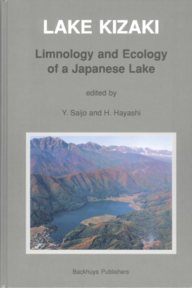

Lake Kizaki is a small lake of about 140 ha with a maximum length of 2.7 km
and a maximum width of 1.2 km. In Lake Kizaki, the first sounding was carried
out in 1907, but unfortunately no definite station as a base for limnological
studies was established, except from 1921 to 1939, when the Fishery Experimental
Station provided facilities for limnological research. This is why there are
no continuous data of basic limnological interest, especially records of the
flora and fauna of Lake Kizaki and the two other Nishina Lakes, Aoki and Nakatsuna,
which are connected in the same water system.
Although Lake Kizaki is located at the foot of the Japanese Northern Alps and
the altitude of its surface is 764 m, a distinct thermal stratification with
a temperature difference between layers of about 15 °C forms in summer.
The water temperature near the bottom is 5 to 7 °C throughout the year.
Due to this thermal condition, an oxygen deficiency prevails near the lake bottom
from summer to autumn until overturn. Associated with the seasonal succession
of water temperature and the vertical distribution of oxic and anoxic conditions,
dynamic changes in chemical conditions and related microbial activity have long
been observed in this lake. Furthermore, the lake is of a convenient size for
extensive studies, so that it is easy to follow changes in the lake even daily
or at one meter depth intervals. Lake Kizaki is thus an ideal field location,
which explains why so many biogeochemical and microbial studies have been made
on this lake.
Contents
Dedication - Contents - Foreword - Acknowledgements - Authors' addresses
Part 1: General background:
Chapter 1: Geography, Y Saijo;
Chapter 2: Geology and geomorphology, Y. Ota;
Chapter 3: Meteorology, K. Hoshikawa;
Chapter 4: Hydrology, T. Ariai
Part 2: The Lacustrine environment:
Chapter 5: Paleolimnological studies, F. Kumon;
Chapter 6: Physical Environment: a. Optical environment, M. Kishino & H.
Hayashi; b. Water temperature, T. Arai & H. Hayashi; c. Water motions, T.
Arai;
Chapter 7: Chemical environment: a. Chemical properties of water, K. Fukushima;
b. Dissolved oxygen and carbon dioxide, H. Hayashi
Part 3: Biogeochemistry:
Chapter 8: Organic chemistry of water and sediment: a. Decomposition of organic
matter in water and sediments, K. Matsunaga, T. Koyama & T. Tomino; b. Chemical
composition of dissolved organic matter, T. Hama & N. Handa; c. Lipid compounds
in sediments, M. Nishimura; d. Artificial compounds in sediments, K. Ogura;
Chapter 9: Nitrogen metabolism: a. Nitrogen metabolism in the aerobic layer,
M. Takahashi; b. Denitrification in the anoxic hypolimnetic water column and
sediment, H. Terai & M. Yoh;
Chapter 10: Sulfur metabolism, H. Hayashi & Y. Watanabe;
Chapter 11: Greenhouse gases: a. Nitrous oxide, M. Yoh & H. Terai; b. Seasonal
changes in dissolved methane and methane flux to the atmosphere, M. Takita,
M. Sakamoto, S. Takeshima & H. Terai;
Chapter 12: Stable isotope studies, T. Yoshioka
Part 4: Microbial ecology:
Chapter 13: Microbial process in matter flux: a. Microbial ecology in carbon
flux, K. Kato; b. Bacterial function in the grazing food chain and microbial
loop, G. Tóth & K. Kato;
Chapter 14: Microbial nitrogen metabolism: a. Microbial ecological approach
to denitrification, D.S. Abe & K. Kato; b. Influence of radiation on nitrification
T. Yoshioka; c. Ammonium regeneration within the euphotic zone, H. Haga, T Nagata
& M. Sakamoto;
Chapter 15: Phosphorus and phosphate-solubilizing bacteria, Y Yamamoto;
Chapter 16: Sulfate-reducing bacteria, S. Takij, J. Li & H. Hayashi
Part 5: Ecological aspects:
Chapter 17: Macrophytes, M. Nagasaka, M. Funakoshi H. Hayashi;
Chapter 18: Phytoplankton: a. Changes in the species composition of phytoplankton,
H. Kiyosawa; b. Chlorophyll a and primary production, T. Yoshioka & H. Hayashi;
c. Diatoms, H. Kiyosawa, H. Hayashi & T. Murakami; d. Anabaena and algophorous
amoebae, M. Funakoshi, H. Kiyosawa & H. Hayashi; e. Algalytic microbes,
Y. Yamamoto; f. Freshwater red tides of Peridinium bipes, H.D. Park;
Chapter 19: Zooplankton, T. Sekino & T. Hanazato;
Chapter 20: Benthic fauna: a. Macroinvertebrates, K. Hirabayashi; b. Mollusca,
T. Fujita; c. Insects, T. Yoshida & M. Uenishi;
Chapter 21: Vertebrates: a. Amphibia, T. Nagasawa; b. Fish, M. Yamamoto; c.
Changes in the waterfowl community, H. Nakamura
Part 6: Recent ecosystem changes due to human activities:
Chapter 22: Fisheries in Nishina Three Lakes, H. Hayashi;
Chapter 23: Eutrophication and the nutrient balance, T. Okino & Y. Watanabe;
Chapter 24: Disturbance of the lake ecosystem, H. Hayashi;
Chapter 25: Future perspectives for Nishina Three Lakes, Y. Saijo & H. Hayashi;
References - Subject index - Taxonomic index.